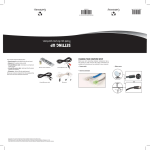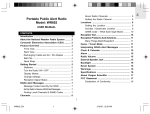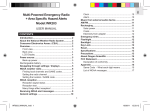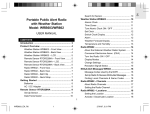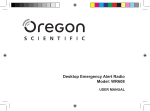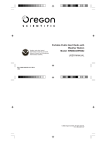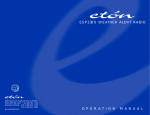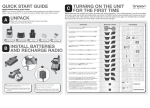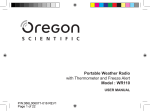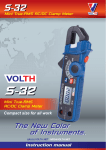Download Multi-Powered Emergency Radio + Hazard Alerts Model:WR202
Transcript
1. Solar panel RECHARGING 2. SNOOZE: activate snooze alarm / backlight SOLAR POWER 3. Antenna 4. Multi-Powered Emergency Radio + Hazard Alerts Model:WR202 Expose the solar panel directly to sunlight. : turn flashlight on/off TIPS 5. Light 6. Headphone jack 7. Audio line-in jack 8. DC adapter jack 9. Mobile phone charger jack and charger switch 10. Battery compartment USER MANUAL 11. RESET: return unit to default settings EN Keep this manual handy as you use your new product. It contains practical step-by-step instructions as well as technical specifications and warnings you should know about. 1 2 1. : radio is on and AM/FM is selected 2. 3 4 5 6 : NOAA weather radio is on • It takes approximately 30 hours to fully charge the battery by solar power (under strong light conditions). Do not scratch the solar panel’s surface or wipe it with strong detergent. Do not expose the solar panel to rain, snow or moisture. The duration of the rechargeable battery’s charging or operating time is determined by either the intensity of sunlight or the position of the solar panel towards the sun. Do not overcharge the batteries. NOTE Solar panel cannot be used to charge mobile phone. CRANK 5. Mobile phones can only be charged by cranking or by adapter (separate purchase required). 6. : back-up battery level indicator : alarm clock is enabled BACK-UP POWER 3 4 5 6 7 8 9 10 1. VOL knob: adjust volume (0-7) : turn emergency alarm on/off : turn radio on/off and toggle between AM/FM 4. : auto search / adjust radio frequency 5. : activate / deactivate alarm function; set alarm 6. MODE: toggle between different clock / calendar displays; set clock; confirm clock setting 8. Northern Hemisphere 4. Clock / calendar : increase / decrease value of the setting : turn NOAA weather radio on / off 9. Crank: wind to charge battery or mobile phone 10. LED indicator: continuous red light to indicate unit / mobile phone is charging; flashing red light to indicate rechargeable battery is low; green light to indicate radio is on . 1. Slide charger switch to 2. Lift crank and wind clockwise. In cases where rechargeable battery power is low or has no power, the unit will source its energy from the back-up batteries. To charge mobile phone: 1. Using USB cable (not included) connect one end to the mobile phone and the other end to mobile phone charger jack. Insert 3 AAA batteries: 2. Slide charger switch to select 3. Lift crank and wind clockwise. indicates there is no back-up battery or back-up battery is low. 7. Southern Hemisphere South 3. Radio frequency / volume 2. Insert the batteries matching the polarities. 3. North • 1. Slide open battery compartment. 2. if you reside in the: • POWER SOURCE FRONT VIEW 2 Direct solar panel as follows: To charge unit: OVERVIEW 1 • Solar panel facing: • The Multi-powered emergency radio keeps you alert of changing weather conditions and also entertained. Plug in and listen to your personal music collection, your favorite radio station or up-to-date weather warnings. With clock and alarm, keep track of time and wake up bright and ready for a new day of exploring and enjoying the natural surroundings. With the addition of an emergency siren, flashlight and ability to charge your mobile phone, this Multi-Powered Emergency Radio is a must-have item for your outdoor adventures. For best results when charging the battery, place the solar panel directly with view to sunlight. • LCD DISPLAY INTRODUCTION • . NOTE 1 minute of winding can power the radio for approx. 5 minutes. It would take approximately 85 minutes of continuous winding (2 turns per second) to fully charge the battery. It is recommended to insert back-up batteries in case of power shortage during emergencies. ELECTRICITY FROM ADAPTER RECHARGEABLE BATTERY 1. Lift the soft plastic cover located on the back of the unit. This radio has a built-in rechargeable battery that can store energy from different sources: a solar panel, a manual hand crank or electricity via an adapter (not included in package). 2. Plug adapter into the unit and the other end to wall outlet. When rechargeable battery level is low, red LED indicator light will flash. 1. Remove battery compartment cover. To use this feature, purchase a 5V adapter. 3. Slide charger switch accordingly. charge mobile charge unit 2. Insert battery pack. NOTE It takes 7 hours to fully charge the battery by using an adapter, which is not included. 3. Align holes in the connector with the pins, then push connector in. CLOCK AND CALENDAR To set the clock: 1. Press and hold MODE to enter clock settings. to change the settings. Hold to 2. Press speed through the settings. BACK VIEW 3. Press MODE to confirm and move to next setting. The settings order is: hour format, hour, minute, year, calendar format (M-D / D-M), month, day and language (E, F, S). 1 2 To quick exit, press any button except MODE, or SNOOZE. 3 To change display: press MODE. 4 5 6 7 8 9 10 11 4. Tuck wires in and ensure they are within the battery compartment area. ALARM 5. Close battery compartment cover. 1. Press and hold to enter alarm setting. 2. Press to change hour. Press to confirm. Continue with setting minute the same way. To display alarm time and activate / deactivate alarm: Press . means alarm is ON. -:-- means alarm is disabled. To silence the alarm: • Press SNOOZE to silence it for 8 minutes OR • Press any key to turn the alarm off and activate it again after 24 hours. MUSIC FROM EXTERNAL AUDIO DEVICE NOTE NOAA weather radio has to be first turned off. Using a cable (not provided), plug one end to your music storage device and one end to audio line-in socket located at the back of the unit. AM/FM To turn radio on / off: Press . Examples of which radio to choose for a particular location is given in the far right column in above chart. CHANNEL CORRESPONDING RADIO FREQUENCY 162.400 MHz 162.425 MHz 162.450 MHz 162.475 MHz 162.500 MHz 162.525 MHz 162.550 MHz 1 2 3 4 5 6 7 EMERGENCY SIREN Push alarm on. switch outward to turn emergency To turn alarm off, push original position. switch back to its FLASHLIGHT Press to turn flashlight on / off. Green light indicates radio is on. BACKLIGHT To select frequency: Press SNOOZE to activate backlight for 5 seconds. 1. Press again to select AM or FM. 2. Press and hold to auto search or press to manually select frequency. RESET To change volume: Turn VOL knob. Press RESET (located in the back-up battery compartment) to return to default settings. NOTE When charging, even if radio is on, indicator will be red. SPECIFICATIONS NOTE To listen to the radio, ensure line-in cable is not connected. NOAA WEATHER RADIO FINDING LOCAL CHANNELS National Weather Service uses one of 7 preset radio frequencies for their NOAA Weather Radio transmitters across the country. Please refer to the below phone number and website link to find the right channel for your local county: To contact the NWS by telephone: 1. Phone 1-888-NWR-SAME (1-888-697-7263). 2. Follow prompts through a simple voice menu. TYPE LxWxH Weight AM radio FM radio Battery DC adaptor PRECAUTIONS • • To obtain NWS radio channels on the internet: 1. Locate www.nws.noaa.gov/nwr/indexnw.htm • 2. Click the State for which information is needed. For example, clicking on “Montana” will give a list of information relevant to the State of Montana including the names of counties, NWR transmitter locations, the frequency of the transmitter, the strength of the signal in WATTS, and any remarks as applicable. Example of the first 10 county radio channels: FREQ CALL CHOOSE COUNTY NWR TRANS MHZ RADIO MITTER CHANNEL Beaverhead Butte,MT 162.550 WXL79 7 Beaverhead Dillon,MT 162.475 WNG638 4 Big Horn Billings,MT 162.550 WXL27 7 Blaine Havre, MT 162.400 WXL53 1 Blaine Billings MT 162.475 WWG85 4 Broadwater Helena, MT 162.400 WXK66 1 Carbon Billings MT 162.550 WXL27 7 Carter Baker, MT 162.550 WXK57 7 Cascade Great Falls, 162.550 WXJ43 7 MT Chouteau Miles Hill, MT 162.500 WWG84 5 After identifying the frequency of your local NOAA Weather Radio transmitter, refer to below table to find the corresponding channel (1-7). 1. Press to turn NOAA weather radio on. 2. Press to select channel 1-7. DESCRIPTION 7.5 x 2.1 x 3.9 in (191 x 54 x 98mm) 14.1 oz (400g) 520 – 1710 KHz 88 – 108 MHz 3 x UM-4 AAA batteries (for back-up) 600mAh 3.6V Ni-MH rechargeable battery DC5V 500mA (not included) • • • • • • • • • Do not subject the unit to excessive force, shock, dust, temperature or humidity. Do not cover the ventilation holes with any items such as newspapers, curtains etc. Do not immerse the unit in water. If you spill liquid over it, dry it immediately with a soft, lint-free cloth. Do not clean the unit with abrasive or corrosive materials. Do not tamper with the unit’s internal components. This invalidates the warranty. Only use fresh batteries. Do not mix new and old batteries. Images shown in this manual may differ from the actual display. When disposing of this product, ensure it is collected separately for special treatment and not as household waste. Placement of this product on certain types of wood may result in damage to its finish for which Oregon Scientific will not be responsible. Consult the furniture manufacturer's care instructions for information. The contents of this manual may not be reproduced without the permission of the manufacturer. Do not dispose old batteries as unsorted municipal waste. Collection of such waste separately for special treatment is necessary. Please note that some units are equipped with a battery safety strip. Remove the strip from the battery compartment before first use. NOTE The technical specifications for this product and the contents of the user manual are subject to change without notice. NOTE Features and accessories will not be available in all countries. For more information, please contact your local retailer. ABOUT OREGON SCIENTIFIC Visit our website (www.oregonscientific.com) to learn more about Oregon Scientific products. If you're in the US and would like to contact our Customer Care department directly, please visit: https:// us.oregonscientific.com/service/support.asp For international inquiries, please visit: http:// us.oregonscientific.com/about/international.asp FCC STATEMENT This device complies with Part 15 of the FCC Rules. Operation is subject to the following two conditions: (1) This device may not cause harmful interference, and (2) This device must accept any interference received, including interference that may cause undesired operation. WARNING Changes or modifications not expressly approved by the party responsible for compliance could void the user’s authority to operate the equipment. NOTE This equipment has been tested and found to comply with the limits for a Class B digital device, pursuant to Part 15 of the FCC Rules. These limits are designed to provide reasonable protection against harmful interference in a residential installation. This equipment generates, uses and can radiate radio frequency energy and, if not installed and used in accordance with the instructions, may cause harmful interference to radio communications. However, there is no guarantee that interference will not occur in a particular installation. If this equipment does cause harmful interference to radio or television reception, which can be determined by turning the equipment off and on, the user is encouraged to try to correct the interference by one or more of the following measures: • Reorient or relocate the receiving antenna. • Increase the separation between the equipment and receiver. • Connect the equipment into an outlet on a circuit different from that to which the receiver is connected. • Consult the dealer or an experienced radio / TV technician for help. DECLARATION OF CONFORMITY The following information is not to be used as contact for support or sales. Please visit our website at http://us.oregonscientific.com/service/ for all enquiries. We Name: Oregon Scientific, Inc. Address: 19861 SW 95th Ave.,Tualatin, Oregon 97062 USA Telephone No.: 1-800-853-8883 declare that the product Product No.: WR202 Product Name: Multi-Powered Emergency Radio + Hazard Alerts Manufacturer: IDT Technology Limited Address: Block C, 9/F, Kaiser Estate, Phase 1, 41 Man Yue St., Hung Hom, Kowloon, Hong Kong is in conformity with Part 15 of the FCC Rules. Operation is subject to the following two conditions: 1) This device may not cause harmful interference. 2) This device must accept any interference received, including interference that may cause undesired operation. © 2011 Oregon Scientific. All rights reserved. P/N:300103042-00001-10




